1995 GMC SIERRA brake
[x] Cancel search: brakePage 14 of 488
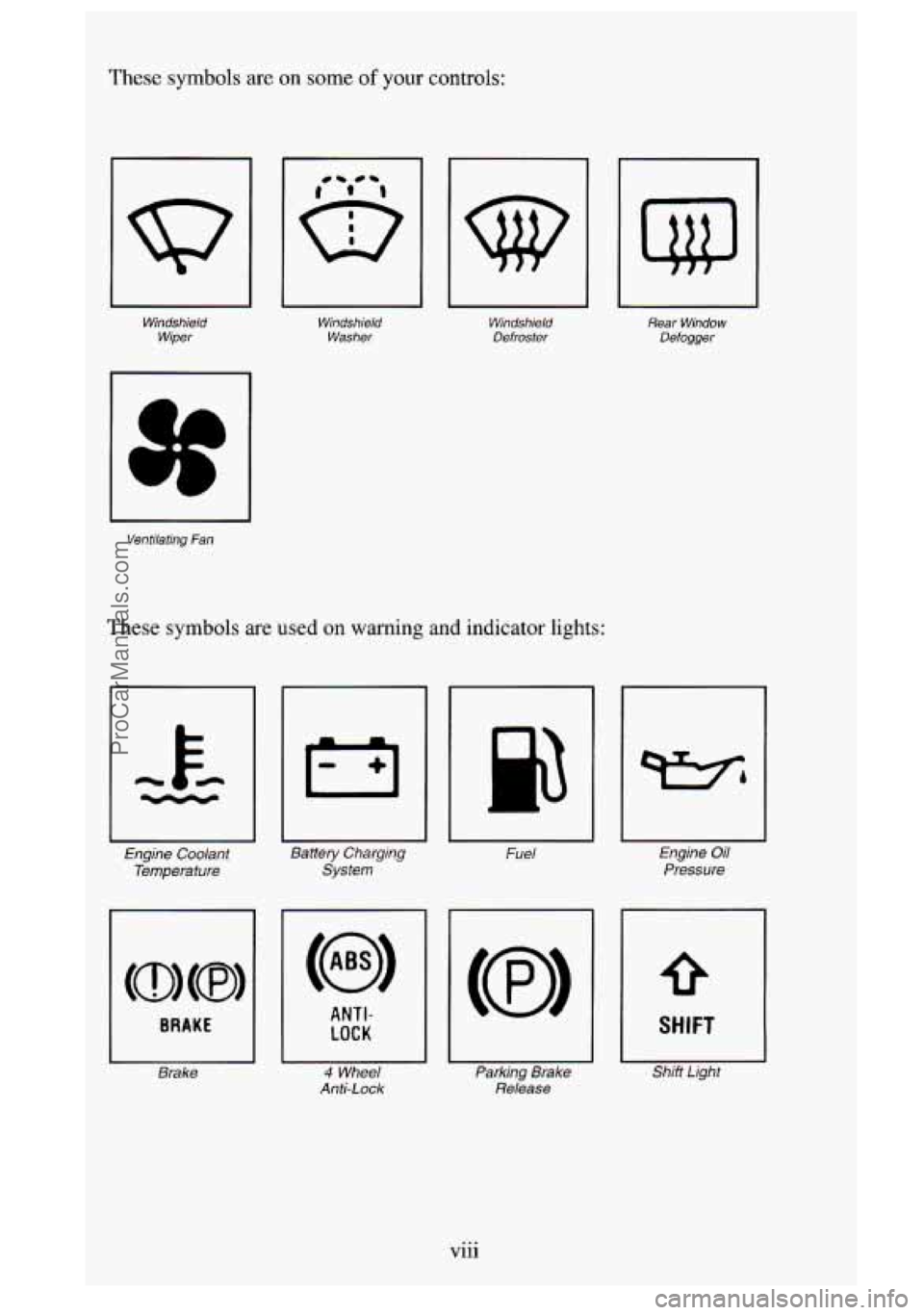
These symbols are on some of your controls:
uu
Windshield Wiper Windshield
Washer
I I
Windshield Defroster
Ventilating Fan
These symbols are used on warning and indicator lights:
Engine Coolant
Temperature
~~
Battery Charging
System
BRAKE
Brake
ANTI-
LOCK
4 Wheel
Anti-Lock
I 1
Rear Window
Defogger
Fuel
Parking Brake
Release
Engine Oil
Pressure
SHIFT
Shift Lighf
Vlll . ..
ProCarManuals.com
Page 71 of 488
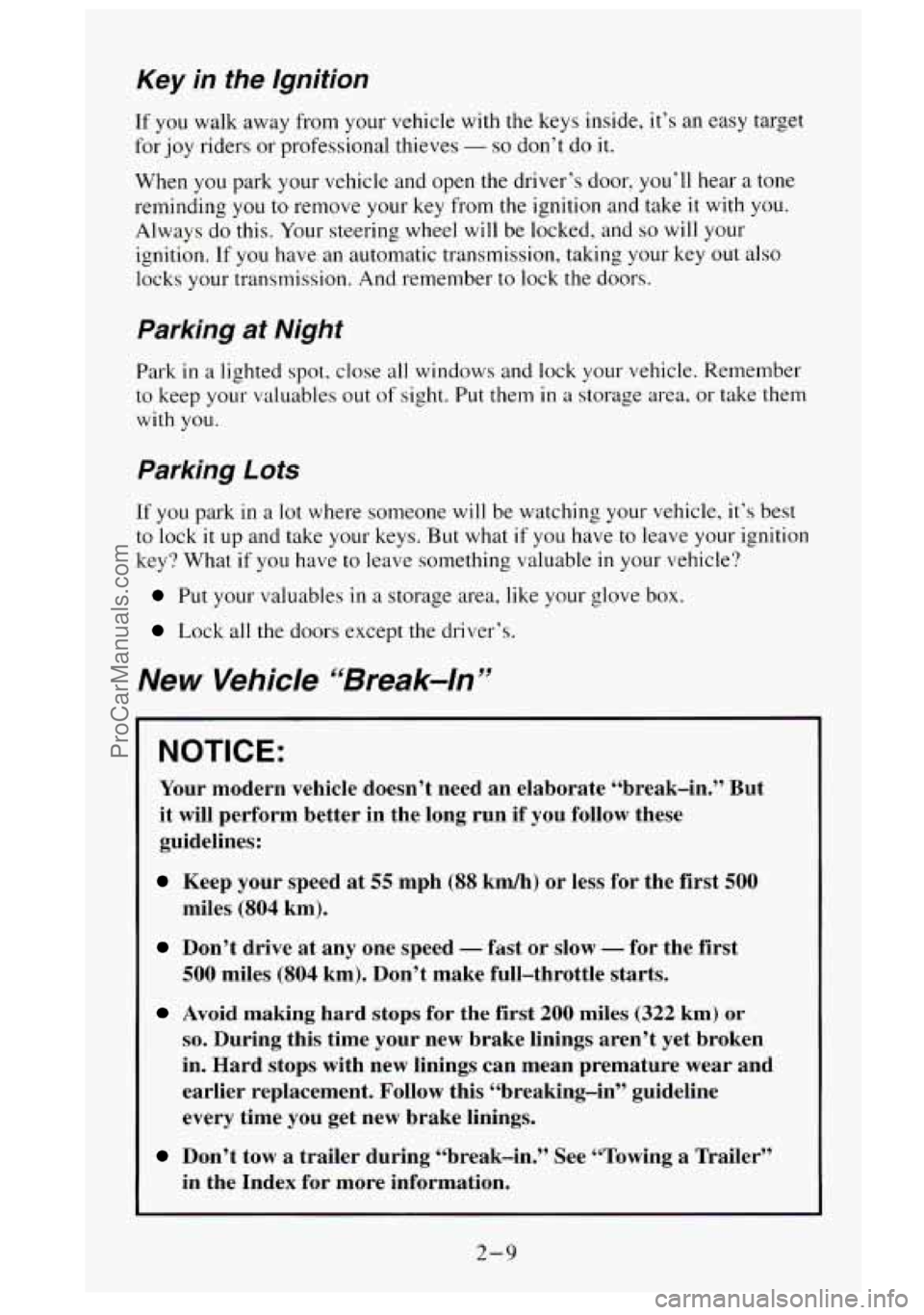
Key in the Ignition
If you walk away from your vehicle with the keys inside, it’s an easy target
for joy riders or professional thieves
- so don’t do it.
When you park your vehicle and open the driver’s door, you‘ll hear a tone
reminding
you to remove your key from the ignition and take it with you.
Always do this.
Your steering wheel will be locked, and so will your
ignition. If you have
an automatic transmission, taking your key out also
locks your transmission. And remember to lock the doors.
Parking at Night
Park in a lighted spot, close all windows and lock your vehicle. Remember
to keep
your valuables out of sight. Put them in a storage area, or take them
with
you.
Parking Lots
If you park in a lot where someone will be watching your vehicle, it‘s best
to lock
it up and take your keys. But what if you have to leave your ignition
key? What if
you have to leave something valuable in your vehicle?
Put your valuables in a storage area, like your glove box.
Lock all the doors except the driver’s.
New Vehicle “Break-In ”
NOTICE:
Your modern vehicle doesn’t need an elaborate “break-in.” But
it will perform better in the long run if you follow these
guidelines:
Keep your speed at 55 mph (88 km/h) or less for the first 500
miles (804 km).
Don’t drive at any one speed - fast or slow - for the first
500 miles
(804 km). Don’t make full-throttle starts.
Avoid making hard stops for the first 200 miles (322 km) or
so. During this time your new brake linings aren’t yet broken
in. Hard stops with new linings can mean premature wear and
earlier replacement. Follow this “breaking-in” guideline
every time you get new brake linings.
Don’t tow a trailer during “break-in.” See “Towing a Trailer”
in the Index
for more information.
2-9
ProCarManuals.com
Page 72 of 488
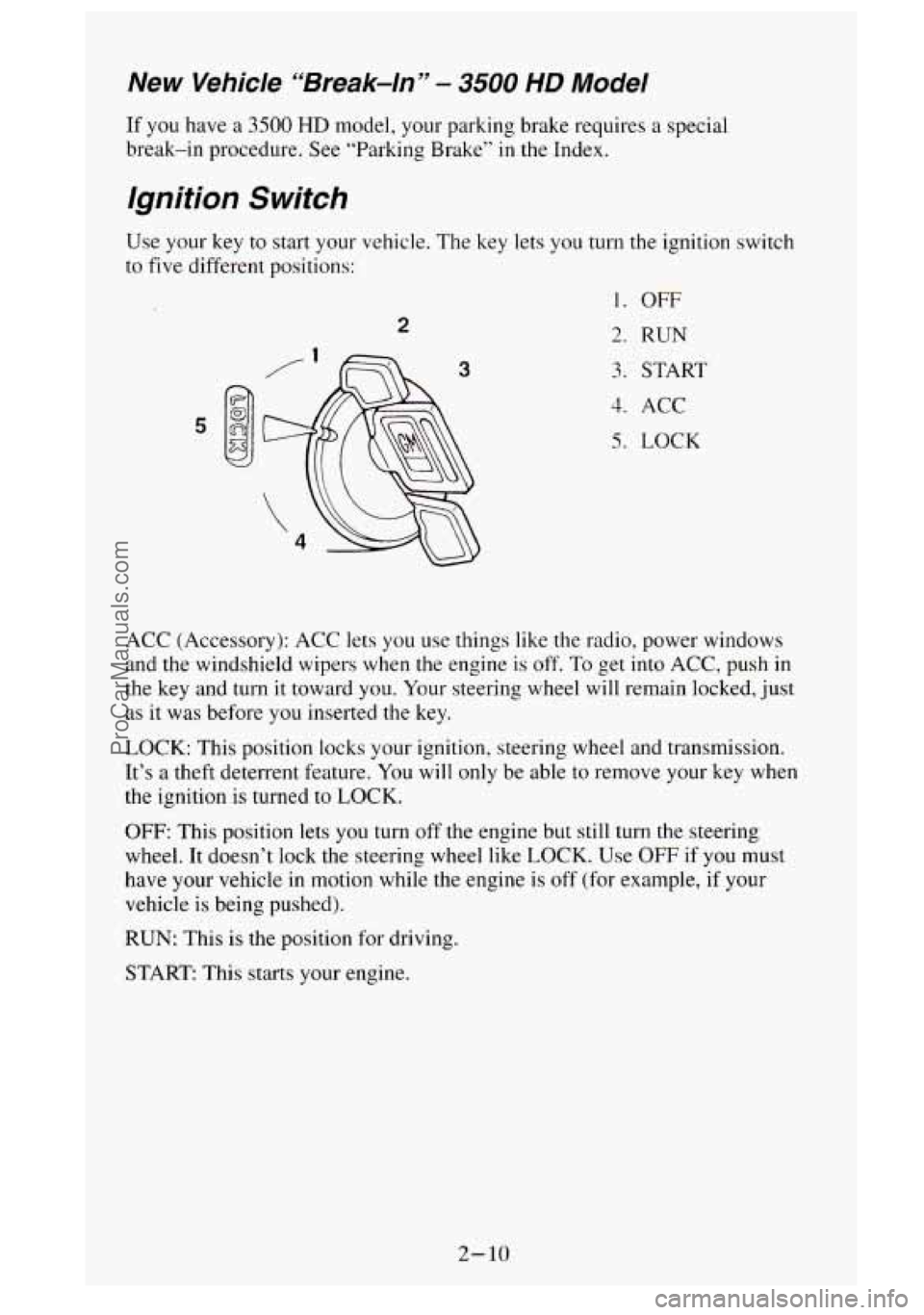
New Vehicle “Break-In” - 3500 HD Model
If you have a 3500 HD model, your parking brake requires a special
break-in procedure. See “Parking Brake”
in the Index.
Ignition Switch
Use your key to start your vehicle. The key lets you turn the ignition switch
to five different positions:
2
5
1. OFF
2. RUN
3. START
4. ACC
5. LOCK
ACC (Accessory):
ACC lets you use things like the radio, power windows
and the windshield wipers when the engine is off. To get into ACC, push in
the key and turn it toward you. Your steering wheel will remain locked, just
as it was before you inserted the key.
LOCK: This position locks your ignition, steering wheel and transmission.
It’s
a theft deterrent feature. You will only be able to remove your key when
the ignition
is turned to LOCK.
OFF: This position lets you turn off the engine but still turn the steering
wheel. It doesn’t lock the steering wheel like LOCK. Use
OFF if you must
have your vehicle
in motion while the engine is off (for example, if your
vehicle is being pushed).
RUN: This is the position for driving.
START: This starts your engine.
2- 10
ProCarManuals.com
Page 82 of 488
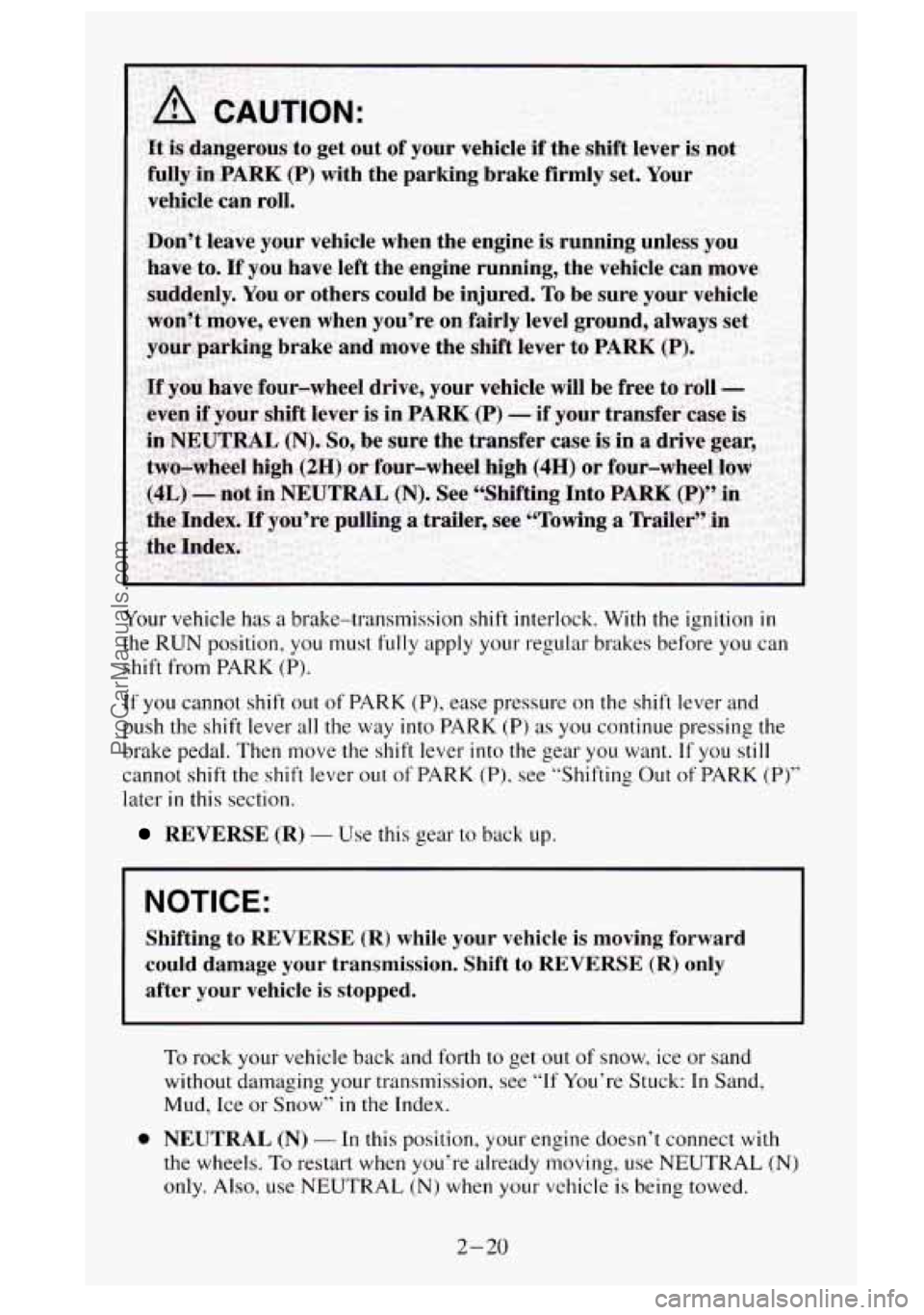
Your vehicle has a brake-transmission shift interlock. With the ignition in
the RUN position, you must fully apply your regular brakes before you can
shift from PARK (P).
If you cannot shift out of PARK (P), ease pressure on the shift lever and
push the
shift lever all the way into PARK (P) as you continue pressing the
brake pedal.
Then move the shift lever into the gear you want. If you still
cannot shift the shift lever out of
PARK (P), see ”Shifting Out of PARK (P)”
later in this section.
REVERSE (R) - Use this gear to back up.
NOTICE:
Shifting to REVERSE (R) while your vehicle is moving forward
could damage your transmission. Shift to REVERSE
(R) only
after your vehicle is stopped.
To rock your vehicle back and forth to get out of snow, ice or sand
without damaging your transmission, see
“If You‘re Stuck: In Sand,
Mud, Ice or Snow”
in the Index.
a NEUTRAL (N) - In this position, your engine doesn’t connect with
the wheels. To restart when you’re already moving, use NEUTRAL (N)
only. Also, use NEUTRAL (N) when your vehicle is being towed.
2-20
ProCarManuals.com
Page 83 of 488
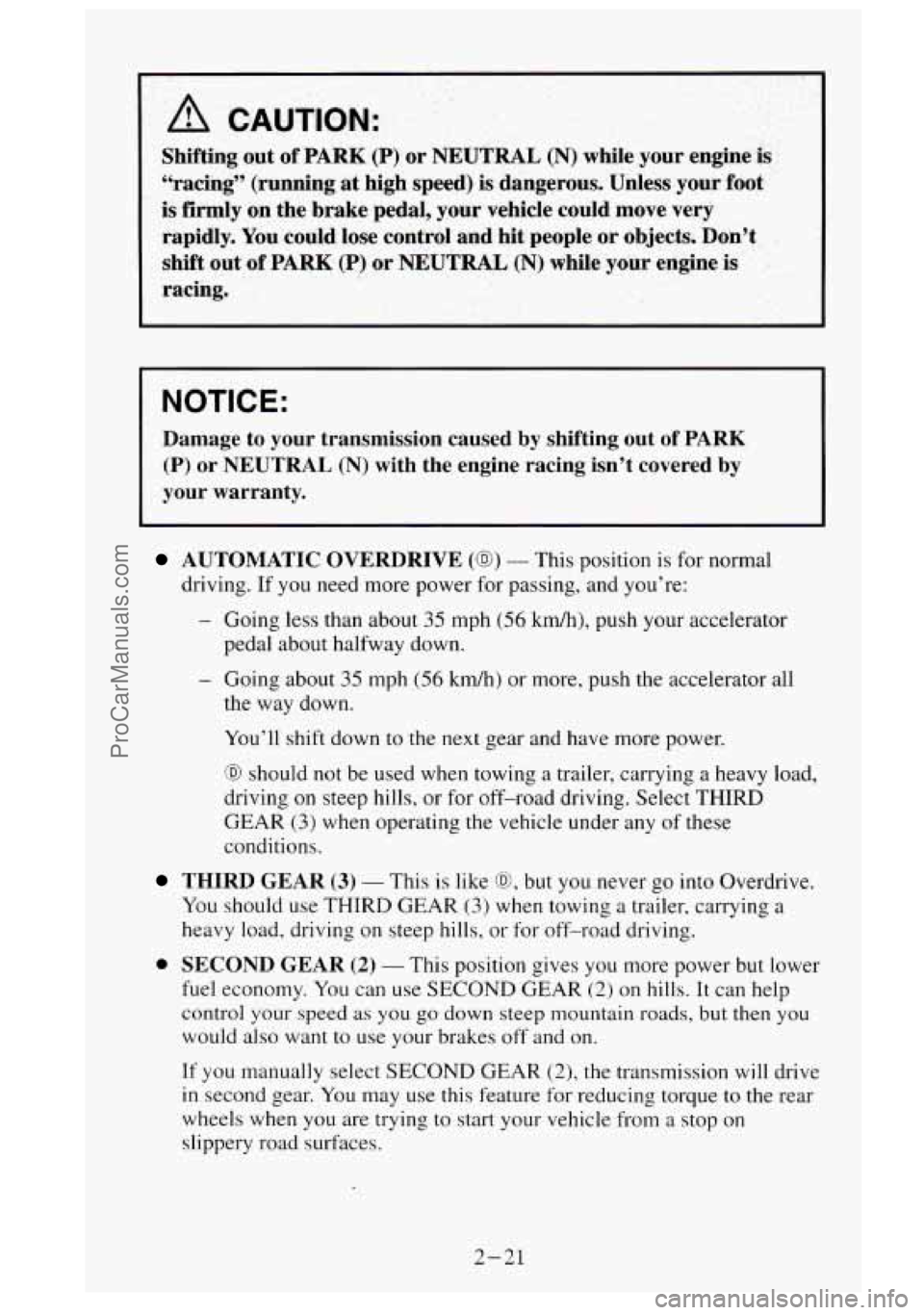
A CAUTION:
Shifting out of PARK (f) or NEUTRAL (N) while your engine is
“racing” (running at high speed) is dangerous. Unless your foot
is firmly on the brake pedal, your vehicle could move very
rapidly.
You could lose control and hit people or objects. Don’t
shift out of
PARK (P) or NEUTRAL (N) while your engine is
racing.
NOTICE:
Damage to your transmission caused by shifting out of PARK
(P) or NEUTRAL (N) with the engine racing isn’t covered by
your warranty.
AUTOMATIC OVERDRIVE (a) - This position is for normal
driving. If you need more power for passing, and you’re:
- Going less than about 35 mph (56 km/h), push your accelerator
pedal about halfway down.
the way down.
You’ll shift down to the next gear and have more power.
- Going about 35 mph (56 kdh) or more, push the accelerator all
0 should not be used when towing a trailer, carrying a heavy load,
driving on steep hills, or for off-road driving. Select THIRD
GEAR
(3) when operating the vehicle under any of these
conditions.
THIRD GEAR (3) - This is like 63, but you never go into Overdrive.
You should use
THIRD GEAR (3) when towing a trailer. carrying a
heavy load, driving on steep hills, or
for off-road driving.
0 SECOND GEAR (2) - This position gives you more power but lower
fuel economy. You can use
SECOND GEAR (2) on hills. It can help
control
your speed as you go down steep mountain roads, but then you
would also want
to use your brakes off and on.
If you manually select SECOND GEAR (2), the transmission will drive
in second gear. You may use this feature for reducing torque to the rear
wheels when you are trying
to start your vehicle from a stop on
slippery road surfaces.
2-21
ProCarManuals.com
Page 84 of 488
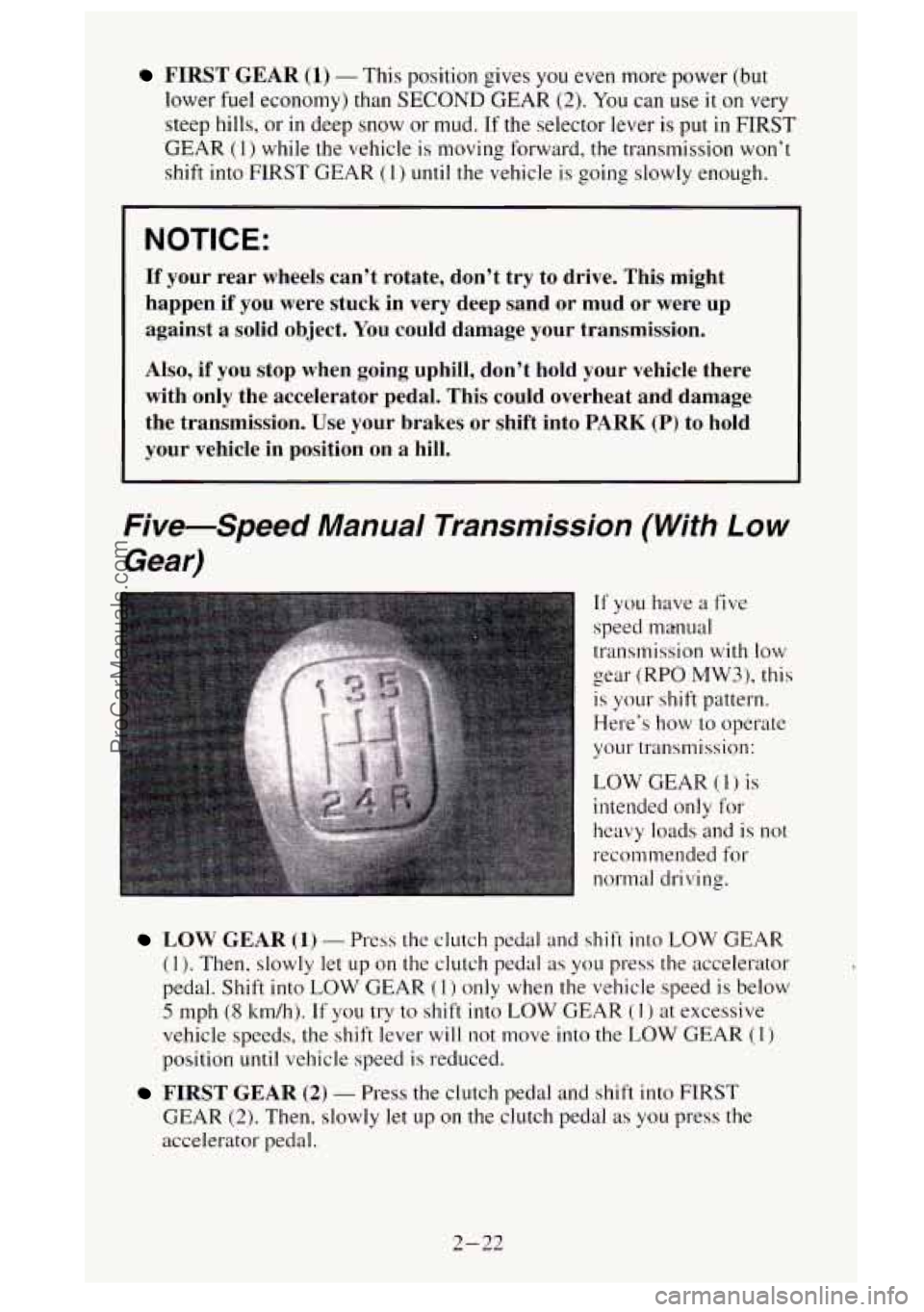
FIRST GEAR (1) - This position gives you even more power (but
lower
fuel economy) than SECOND GEAR (2). You can use it on very
steep hills, or in deep snow or mud. If the selector lever is put in FIRST
GEAR (1) while the vehicle is moving forward, the transmission won’t
shift into FIRST GEAR
(1) until the vehicle is going slowly enough.
NOTICE:
If your rear wheels can’t rotate, don’t try to drive. This might
happen if you were stuck in very deep sand
or mud or were up
against a solid object.
You could damage your transmission.
Also, if you stop when going uphill, don’t hold your vehicle there
with only the accelerator pedal. This could overheat and damage
the transmission.
Use your brakes or shift into PARK (P) to hold
your vehicle in position on a hill.
Five-Spa-ld Manual Transmission (With Low
Gear)
If you have a five
speed manual
transmission with
low
gear (RPO MW3), this
is your shift pattern.
Here’s how to operate
your transmission:
LOW GEAR (1) is
intended only for
heavy loads and is
not
recommended for
normal driving.
LOW GEAR (1) - Press the clutch pedal and shift into LOW GEAR
(1). Then, slowly let up on the clutch pedal as you press the accelerator
pedal. Shift into
LOW GEAR (1) only when the vehicle speed is below
5 mph (8 km/h). If you try to shift into LOW GEAR (I ) at excessive
vehicle speeds, the shift lever
will not move into the LOW GEAR (1)
position until vehicle speed is reduced.
FIRST GEAR (2) - Press the clutch pedal and shift into FIRST
GEAR (2). Then, slowly let up on the clutch pedal as you press the
accelerator pedal.
2-22
ProCarManuals.com
Page 85 of 488
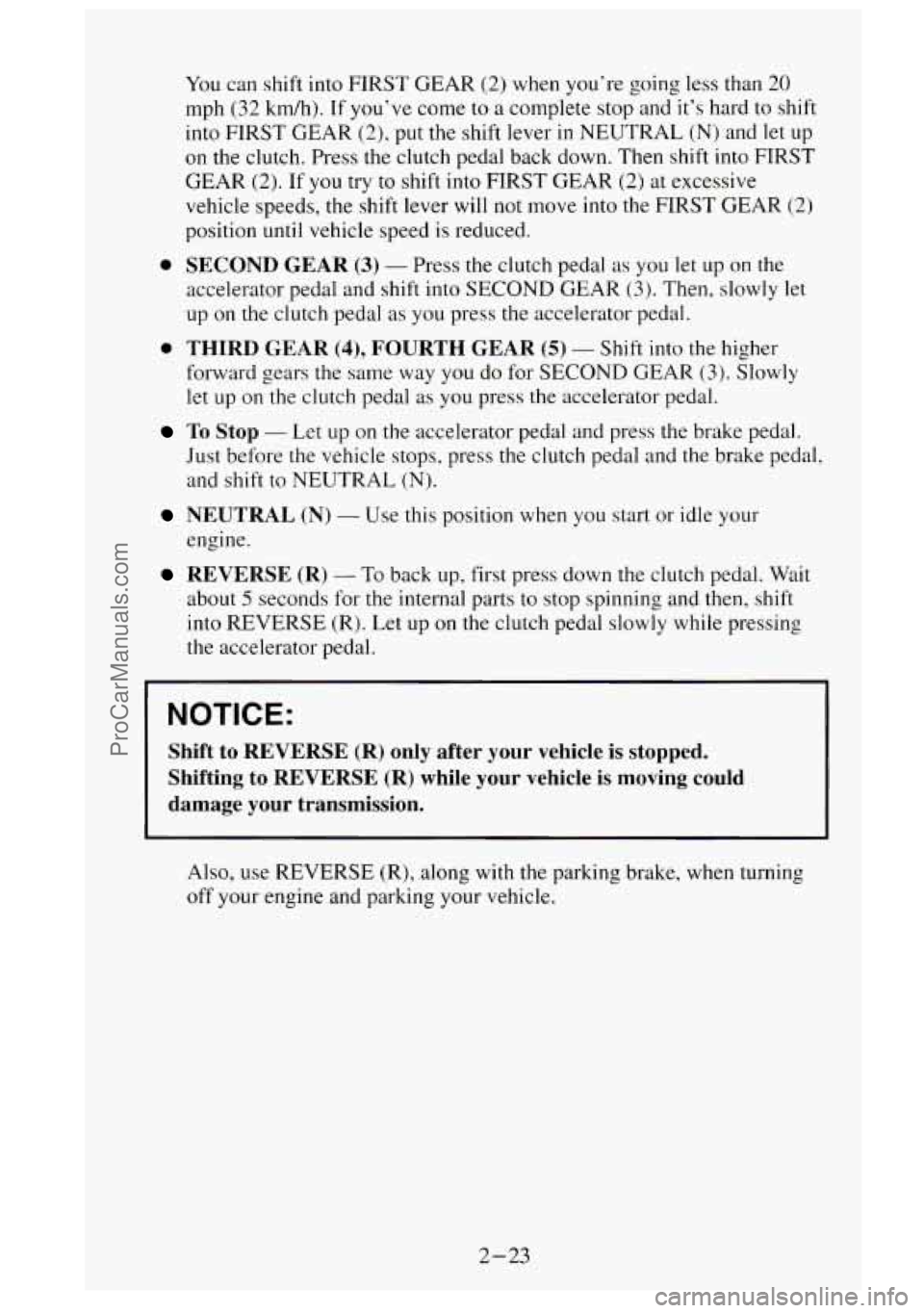
You can shift into FIRST GEAR (2) when you’re going less than 20
mph (32 kmh). If you’ve come to a complete stop and it’s hard to shift
into FIRST GEAR
(2), put the shift lever in NEUTRAL (N) and let up
on the clutch. Press the clutch pedal back down. Then shift into FIRST
GEAR
(2). If you try to shift into FIRST GEAR (2) at excessive
vehicle speeds, the shift lever will not move into the FIRST GEAR
(2)
position until vehicle speed is reduced.
0 SECOND GEAR (3) - Press the clutch pedal as you let up on the
accelerator pedal and shift into SECOND GEAR
(3). Then, slowly let
up on the clutch pedal as you press
the accelerator pedal.
0 THIRD GEAR (4), FOURTH GEAR (5) - Shift into the higher
forward gears
the same way you do for SECOND GEAR (3). Slowly
let up on the clutch pedal as you press the accelerator pedal.
To Stop - Let up on the accelerator pedal and press the brake pedal.
Just before
the vehicle stops, press the clutch pedal and the brake pedal,
and shift to NEUTRAL
(N).
NEUTRAL (N) - Use this position when you start or idle your
engine.
REVERSE (R) - To back up, first press down the clutch pedal. Wait
about
5 seconds for the internal parts to stop spinning and then, shift
into REVERSE (R). Let up
on the clutch pedal slowly while pressing
the accelerator pedal.
NOTICE:
Shift to REVERSE (R) only after your vehicle is stopped.
Shifting to
REVERSE (R) while your vehicle is moving could
damage your transmission.
Also, use REVERSE (R), along with the parking brake, when turning
off your engine and parking your vehicle.
2-23
ProCarManuals.com
Page 86 of 488
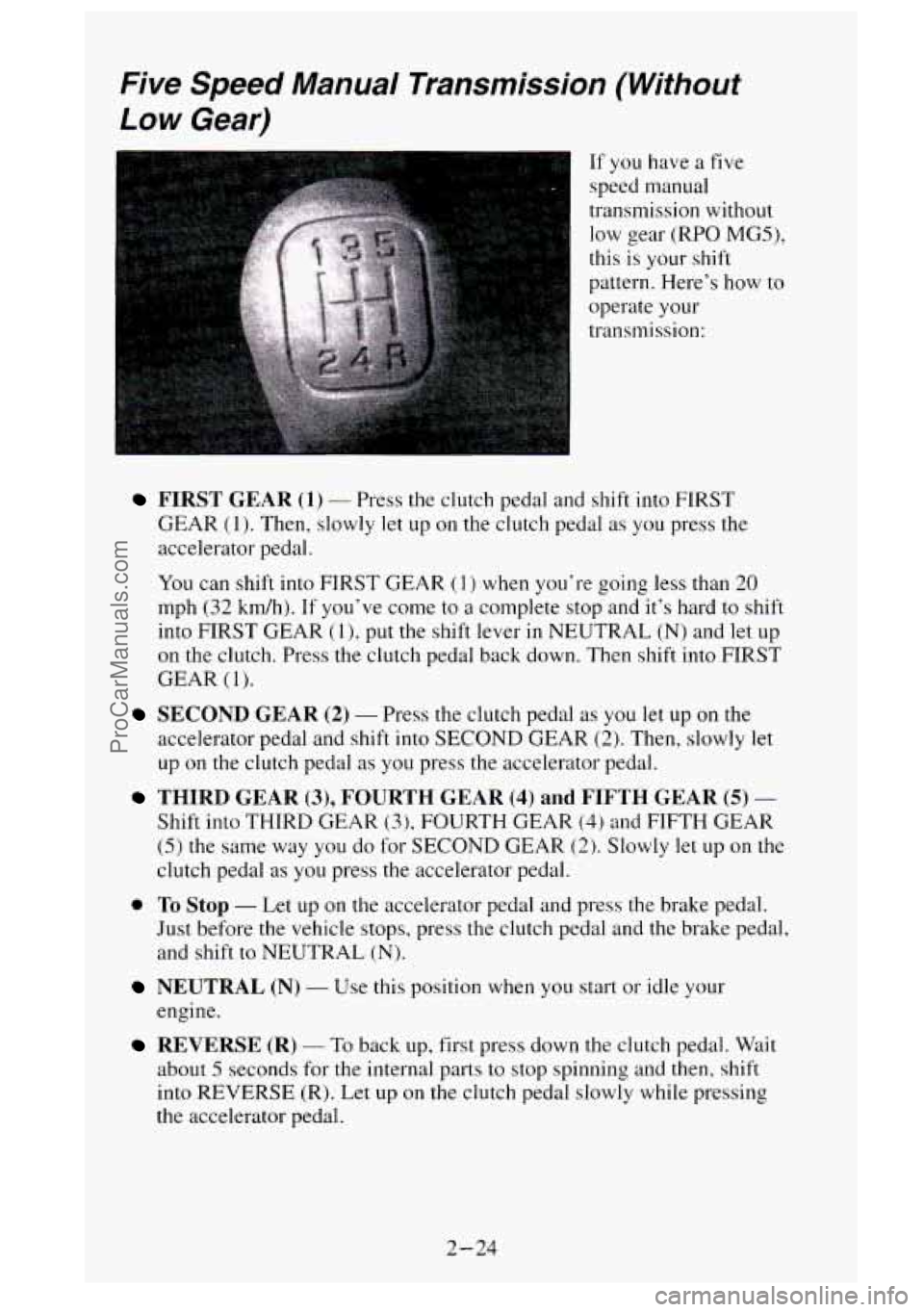
Five Speed Manual Transmission (Without
Low Gear)
6 If you have a five
speed manual
transmission without
low gear
(RPO MG5),
this is your shift
pattern. Here’s how to
operate your
transmission:
FIRST GEAR (1) - Press the clutch pedal and shift into FIRST
GEAR
(1). Then, slowly let up on the clutch pedal as you press the
accelerator pedal.
You can shift into FIRST GEAR (1 ) when you’re going less than 20
mph (32 kdh). If you’ve come to a complete stop and it‘s hard to shift
into FIRST GEAR
(1). put the shift lever in NEUTRAL (N) and let up
on the clutch. Press the clutch pedal back down. Then shift into FIRST
GEAR
(1).
SECOND GEAR (2) - Press the clutch pedal as you let up on the
accelerator pedal and shift into SECOND GEAR
(2). Then, slowly let
up
on the clutch pedal as you press the accelerator pedal.
THIRD GEAR (3), FOURTH GEAR (4) and FIFTH GEAR (5) -
Shift into THIRD GEAR (3). FOURTH GEAR (4) and FIFTH GEAR
(5) the same way you do for SECOND GEAR (2). Slowly let up on the
clutch pedal
as you press the accelerator pedal.
Just before the vehicle stops, press the clutch pedal and the brake pedal,
and shift to NEUTRAL
(N).
0 To Stop - Let up on the accelerator pedal and press the brake pedal.
NEUTRAL (N) - Use this position when you start or idle your
engine.
REVERSE (R) - To back up, first press down the clutch pedal. Wait
about 5 seconds for the internal parts to stop spinning and then, shift
into REVERSE (R). Let up on the clutch pedal slowly while pressing
the accelerator pedal.
2-24
ProCarManuals.com